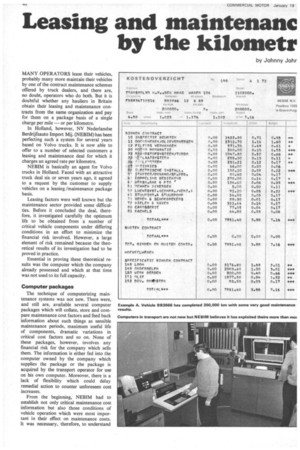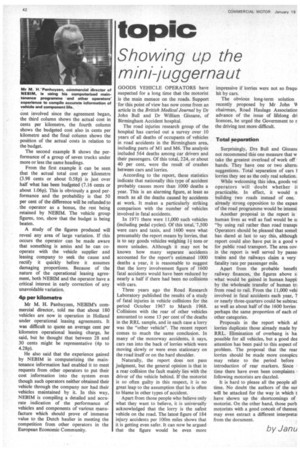Leasing and maintenanc by the kilometr
Page 42

Page 43

Page 44

If you've noticed an error in this article please click here to report it so we can fix it.
by Johnny Johr MANY.OPERATORS lease their vehicles, probably many more maintain their vehicles by one of the contract maintenance schemes offered by truck dealers, and there are, no doubt, operators who do both. But it is doubtful whether any hauliers in Britain obtain their leasing and maintenance contracts from the same organization and pay for them on a package basis of a single charge per mile or per kilometre.
In Holland, however, NV Nederlandse Berdrijfsauto Import Mij. (NEBIM) has been perfecting such a system for several years based on Volvo trucks. It is now able to offer to a number of selected customers a leasing and maintenance deal for which it charges an agreed rate per kilometre.
NEBIM is basically an agent for Volvo trucks in Holland. Faced with an attractive truck deal six or seven years ago, it agreed to a request by the customer to supply vehicles on a leasing /maintenance package basis.
Leasing factors were well known but the maintenance sector provided some difficulties. Before it concluded the deal, therefore, it investigated carefully the optimum life to be obtained from •a number of critical vehicle components under differing conditions in an effort to minimize the financial risk involved. However, a large element of risk remained because the theoretical results of its investigation had to be proved in practice.
Essential in proving these theoretical results was the computer which the company already possessed and which at that time was not used to its full capacity.
Computer packages
The technique of computerizing maintenance systems was not new. There were, and still are, available several computer packages which will collate, store and compare maintenance cost factors and feed back information about such things as sensible maintenance periods, maximum useful life of components, dramatic variations in critical cost factors and so on. None of these packages, however, involves any financial risk for the company which sells them. The information is either fed into the computer owned by the company which supplies the package or the package is acquired by the transport operator for use on his own computer. Moreover, there is a lack of flexibility which could delay remedial action to counter unforeseen cost increases.
From the beginning, NEBIM had to establish not only critical maintenance cost information but also those conditions of vehicle operation which were most important in their effect on maintenance costs. It was necessary, therefore, to understand aspect of a customer's operation ler to lay down acceptable conditions :eh particular haulage activity.
iponent behaviour iginally, the object was to provide ination on which disputes about respon,y for large variations in established factors could be settled amicably. turned out, it also provided a means thich NEBIM could advise operators t the most economical way to run their tesses while maintaining their fleet at efficiency. Moreover, because of the ly defined pattern of component be)ur which has emerged, replacement 1 optimum distance can be advised to nate breakdowns and costly down aving considered the operator's :cial stability, the kind of transport ity in which he is engaged, the ency of his operation, the quality of driving staff, and any other factors h might affect the condition of his ;les, NEBIM might be prepared to offer what it now terms "operational rig" facilities. One thing on which it insist before concluding such an agree is the fitting of tachographs.
ormally, maintenance is carried out ugh a national network of 28 dealers NEBIM will authorize an operator carry out work in his own mainnce facility after it has been approved he company's own technical staff.
■ IEBIM's technical staff play an impor part in the formulation of a leasing / itenance agreement, too. It is expected )articipate by providing written preons of the economic useful life of :ponents in relation to the type of ration involved as well as advising on suitability of the vehicle for the kind vork it has to do. Though still onerous, e decisions are made easier by the innation now stored on the company's iputer. The computer information, like commercial packages available, involves compilation of data about individual ides for each operator. Unlike the unercial package, however, it is able to ipare vehicle and component performance a comparable operating basis. In other .ds, NEBIM is so familiar with each tomer's operation that it is able to tch vehicles belonging to different optors but doing more or less the same job ler similar conditions for comparison poses.
he result is that not only is informII available to the operator about the vidual performance of each of his ides but also about the performance of his vehicles in relation to a number of other similarly occupied units.
The examples shown have been prepared by NEBIM for demonstration in order to preserve the confidential status of the information stored. The translation key is as follows: 10 maintenance inspection; 11 greasing: 12 filters: 20 engine repair: 22 fuel system and turbo: 23 exhaust: 24 cooling system: 25 antifreeze: 20 electrics: 31 starter and dynamo: 41 clutch: 42 gearbox and pto: 51 brakes: 52 air brakes and compressor: 61 steering: 71 suspension and shock absorbers: 72 hubs and wheels: 80 bodywork: ' 81 heater: 148 labour: 149 spare parts: 150 work sub-contracted: 151 oil: 152 sundries. Certain consumables such as fuel and tyres would be outside the contract.
Example A refers to vehicle BB8866 which at June 12, 1969, had completed 200,000 kilometres. The first column refers to parts of the vehicle on which work has been done inside (binnen) the contract and then outside (buiten) the contract. Underneath, the classifications refer to areas of labour and spare parts among which the costs have been allocated.
The second column shows the cost of work done in the period under review, the third column shows the cumulative cost involved since the agreement began, the third column shows the actual cost in cents per kilometre, the fourth column shows the budgeted cost also in cents per kilometre and the final column shows the position of the actual costs in relation to the budget.
The second example B shows the performance of a group of seven trucks under more or less the same headings.
From the first example it can be seen that the actual total cost per kilometre (3.98 cents or about 0.58p) is just over half what has been budgeted (7.16 cents or about 1.06p). This is obviously a good performance and the probability is that 50 per cent of the difference will be refunded to the operator as a bonus, the rest being retained by NEBIM. The vehicle gronp figures, too, show that the budget is being beaten.
A study of the figures produced will reveal any area of large variation. If this occurs the operator can be made aware that something is amiss and he can cooperate with the vehicle supplier and leasing company to seek the cause and rectify it quickly before it assumes damaging proportions. Because of the nature of the operational leasing agreement, both NEBIM and the operator have a critical interest in early correction of any unavoidable variation.
4p per kilometre
Mr M. H. Panhuyzen, NEBIM's commercial director, told me that about 180 vehicles are now in operation in Holland under operational leasing agreements. It was difficult to quote an average cent per kilometre operational leasing charge, he said, but he thought that between 28 and 30 cents might be representative (4p to 4.28p).
He also said that the experience gained by NEBIM in computerizing the maintenance information had enabled it to meet requests from other operators to put their cost information into the system even though such operators neither obtained their vehicle through the company nor had their vehicles maintained by it. In this way, NEBIM is compiling a detailed and accurate indication of the performance of vehicles and components of various manufacture which should prove of immense value to the Dutch haulier in meeting the competition from other operators in the European Economic Community.




















































































































